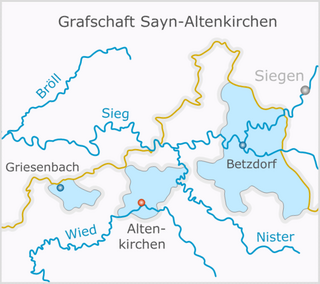
Westphalia is a region of northwestern Germany and one of the three historic parts of the state of North Rhine-Westphalia. It has an area of 20,210 square kilometres (7,800 sq mi) and 7.9 million inhabitants.

Herzogtum Lauenburg is the southernmost Kreis, or district, officially called Kreis Herzogtum Lauenburg, of Schleswig-Holstein, Germany. It is bordered by the district of Stormarn, the city of Lübeck, the state of Mecklenburg-Vorpommern, the state of Lower Saxony, and the city state of Hamburg. The district of Herzogtum Lauenburg is named after the former Duchy of Saxe-Lauenburg.

The Rhein-Sieg-Kreis is a Kreis (district) in the south of North Rhine-Westphalia, Germany. Neighboring districts are Rheinisch-Bergischer Kreis, Oberbergischer Kreis, Altenkirchen, Neuwied, Ahrweiler, Euskirchen, Rhein-Erft-Kreis, the urban district of Cologne. The federal city of Bonn is nearly completely surrounded by the district.

Stade, officially the Hanseatic City of Stade is a city in Lower Saxony in northern Germany. First mentioned in records in 934, it is the seat of the district which bears its name. It is located roughly 45 km (28 mi) to the west of Hamburg and belongs to that city's wider metropolitan region. Within the area of the city are the urban districts of Bützfleth, Hagen, Haddorf and Wiepenkathen, each of which have a council of their own with some autonomous decision-making rights.

In 13 German states, the primary administrative subdivision higher than a Gemeinde (municipality) is the Landkreis or Kreis. Most major cities in Germany are not part of any Kreis, but instead combine the functions of a municipality and a Kreis; such a city is referred to as a kreisfreie Stadt or Stadtkreis.

Amt Neuhaus is a municipality in the District of Lüneburg, in Lower Saxony, Germany. Amt means "municipal office" in German. The original "municipal office of Neuhaus" existed since at least the 17th century until 1885, consecutively as part of Saxe-Lauenburg, Electorate of Hanover (1689-1810), Kingdom of Hanover (1814-1866), and the Prussian Province of Hanover (1866-1885).

Sayn-Wittgenstein-Sayn-Altenkirchen was a German county located in what is now Rhineland-Palatinate, near the river Sieg.

Municipalities are the lowest level of official territorial division in Germany. This can be the second, third, fourth or fifth level of territorial division, depending on the status of the municipality and the Land it is part of. The city-states Berlin and Hamburg are second-level divisions. A Gemeinde is one level lower in those states which also include Regierungsbezirke as an intermediate territorial division. The Gemeinde is one level higher if it is not part of a Gemeindeverband.

Dissen am Teutoburger Wald is an old charactered town in the district of Osnabrück, in Lower Saxony, Germany. It is situated in the Teutoburg Forest, approximately 20 km southeast of Osnabrück.

Neustadt am Main is a community in the Main-Spessart district in the Regierungsbezirk of Lower Franconia (Unterfranken) in Bavaria, Germany and a member of the Verwaltungsgemeinschaft Lohr am Main.

Herford Abbey was the oldest women's religious house in the Duchy of Saxony. It was founded as a house of secular canonesses in 789, initially in Müdehorst by a nobleman called Waltger, who moved it in about 800 onto the lands of his estate Herivurth which stood at the crossing of a number of important roads and fords over the Aa and the Werre. The present city of Herford grew up on this site around the abbey.

Hans-Georg Stephan is a German university professor specializing in European medieval archaeology and post-medieval archaeology.

The War of the Lüneburg Succession was a conflict over the succession to the Principality of Lüneburg that broke out in 1370 in north Germany and lasted, with interruptions, for 18 years. After William II of Lüneburg died without male heirs in 1369, the "Older House of Lüneburg" was extinguished. According to the inheritance rules of the House of Welf to which William belonged, the Duke of Brunswick, Magnus II Torquatus, was entitled to succeed. However, Charles IV ruled that this Imperial Fief should be returned to the Empire and enfeoffed Albert of Saxe-Wittenberg and his uncle, Wenceslas with the Principality, thereby triggering the war.

The Free State of Coburg emerged from the Duchy of Saxe-Coburg and Gotha at the end of the First World War. It existed from November 1918 until its union with the Free State of Bavaria on 1 July 1920.

The Soest Börde is an historical territorial lordship and a cultural landscape in the centre of the German region of Westphalia, between Sauerland in the south and Münsterland in the north. It is known nationally for being a very fertile region thanks to the depth of its loess soils that, it terms of yield are only exceeded in Germany by the Magdeburg Börde.
The Brabant Road, Cologne to Leipzig Road or Liege Road is an ancient road which, during the Middle Ages and Early Modern Period, was one of the most important continental east-west oriented military and trade routes. It ran from the eponymous Duchy of Brabant to Leipzig.
Waldemar R. Röhrbein was a German historian. He worked as a museum director in Lower Saxony, his last post being from 1976 to 1997 at the Historisches Museum Hannover, and was president of the Homeland Federation of Lower Sachsony. He contributed to encyclopedias about Hanover's history and culture.

Hachen is an Ortschaft (subdivision) of the town of Sundern in the Hochsauerland district of North Rhine-Westphalia, Germany. It is the second largest Ortschaft of Sundern.

A Kreis or 'Circle' was an administrative division of the Habsburg monarchy and Austrian Empire between 1748 and 1867.

















